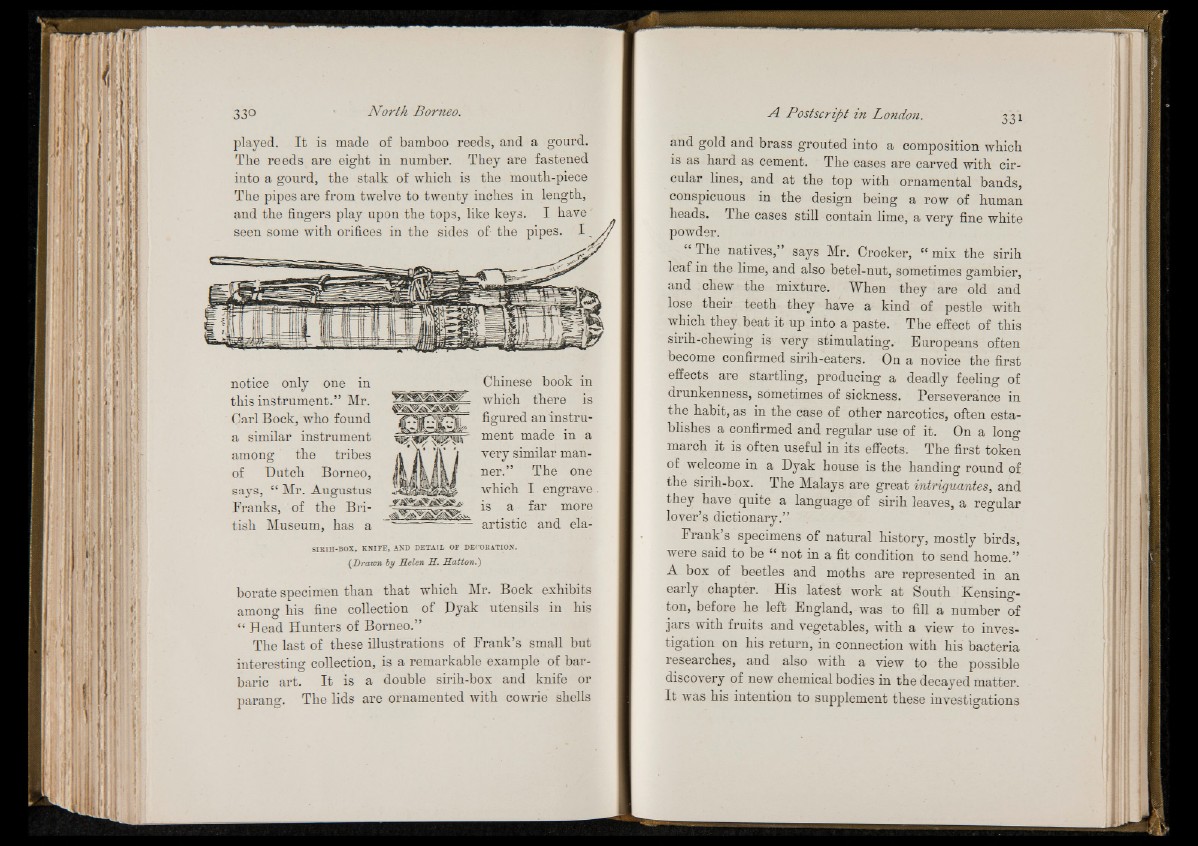
played. I t is made of bamboo reeds, and a gourd.
Tbe reeds are eight in number. They are fastened
into a gourd, the stalk of which is the mouth-piece
The pipes are from twelve to twenty inches in length,
and the fingers play upon the tops, like keys. I have
seen some with orifices in the sides of the pipes. I
notice only one in
this instrument.” Mr.
Carl Bock, who found
a similar instrument
among the tribes
of Dutch Borneo,
says, “ Mr. Augustus
Franks, of the British
Museum, has a
Chinese book in
which there is
figured an instru-
ment made in a
very similar manner.”
The one
which I engrave
is a far more
artistic and ela-
SIBIH-BOX, KNIFE, AND DETAIL OF DECORATION.
(Drawn by Helen H. Hatton.)
borate specimen than that which Mr. Bock exhibits
amono- his fine collection of Dyak utensils in his
“ Head Hunters of Borneo. ’
The last of these illustrations of Frank’s small but
interesting collection, is a remarkable example of barbaric
art. I t is a double sirih-box and knife or
parang. The lids are ornamented with cowrie shells
and gold and brass grouted into a composition which
is as hard as cement. The cases are carved with circular
lines, and at the top with ornamental bands,
conspicuous in the design being a row of human
heads. The cases still contain lime, a very fine white
powder.
“ The natives,” says Mr. Crocker, “ mix the sirih
leaf in the lime, and also betel-nut, sometimes gambier,
and chew the mixture. When they are old and
lose their teeth they have a kind of pestle with
which they beat it up into a paste. The effect of this
sinh-chewing is very stimulating. Europeans often
become confirmed sirih-eaters. On a novice the first
effects are startling, producing a deadly feeling of
drunkenness, sometimes of sickness. Perseverance in
the habit, as in the case of other narcotics, often establishes
a confirmed and regular use of it. On a long
march it is often useful in its effects. The first token
of welcome in a Dyak house is the handing round of
the sirih-box. The Malays are great intriguantes, and
they have quite a language of sirih leaves, a regular
lover’s dictionary.”
Frank s specimens of natural history, mostly birds,
were said to be “ not in a fit condition to send home.”
A box of beetles and moths are represented in an
early chapter. His latest work at South Kensington,
before he left England, was to fill a number of
jars with fruits and vegetables, with a view to investigation
on his return, in connection with his bacteria
researches, and also with a view to the possible
discovery of new chemical bodies in the decayed matter.
I t was his intention to supplement these investigations